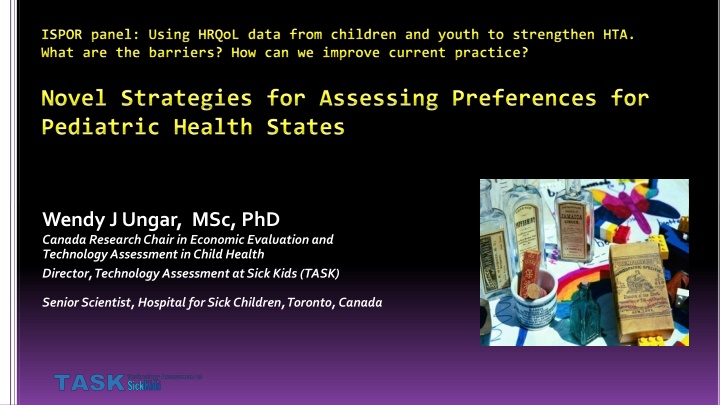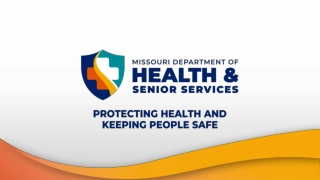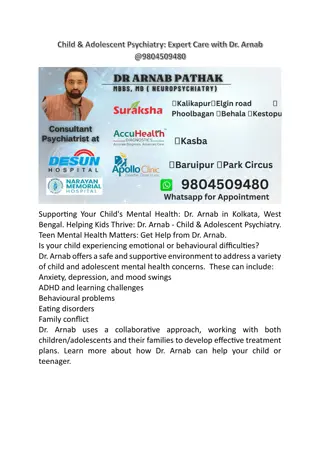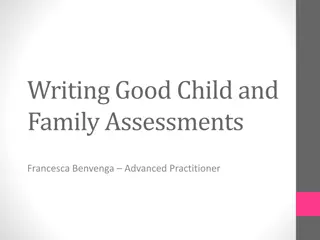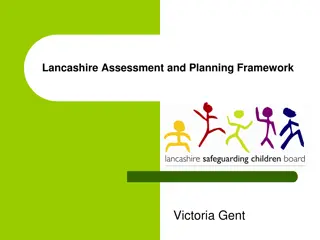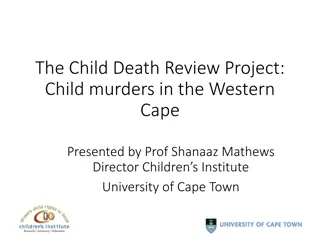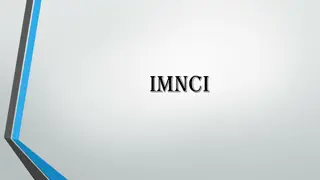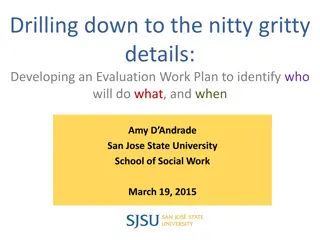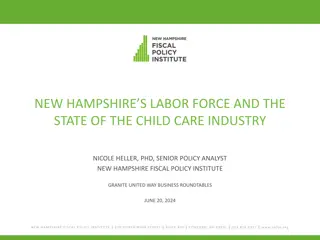Economic Evaluation and Technology Assessment in Child Health
Wendy J. Ungar, MSc, PhD, Canada Research Chair in Economic Evaluation and Technology Assessment in Child Health, shares insights on HRQoL instruments, value sets for young children, and capturing HRQoL in parents/caregivers. Various instruments, preferences used, and dimensions in child-specific QoL attributes are discussed.
Download Presentation

Please find below an Image/Link to download the presentation.
The content on the website is provided AS IS for your information and personal use only. It may not be sold, licensed, or shared on other websites without obtaining consent from the author.If you encounter any issues during the download, it is possible that the publisher has removed the file from their server.
You are allowed to download the files provided on this website for personal or commercial use, subject to the condition that they are used lawfully. All files are the property of their respective owners.
The content on the website is provided AS IS for your information and personal use only. It may not be sold, licensed, or shared on other websites without obtaining consent from the author.
E N D
Presentation Transcript
Wendy J Ungar, MSc, PhD Canada Research Chair in Economic Evaluation and Technology Assessment in Child Health Director, Technology Assessment at Sick Kids (TASK) Senior Scientist, Hospital for Sick Children, Toronto, Canada
Senior Scientist at SickKids The following financial relationships are disclosed: Grant support from Genome Canada, Canadian Institutes for Health Research, US PhRMA Foundation, and the Hospital for Sick Children Research Institute Paid consultant to Broad Street HEOR Inc. Honourarium from the Canadian Fertility and Andrology Society Attendance at ISPOR paid for by the EuroQol Research Foundation The views expressed are those of the presenter and do not represent the views of The Hospital for Sick Children, The Hospital for Sick Children Research Institute, the University of Toronto, Ontario Health, or any other organizations with which the presenter is affiliated.
180 160 140 120 Number of Records 100 80 60 40 20 0 1980 1984 1988 1992 1996 2000 2004 2008 2012 2016 2020 1600 CBA CEA 1400 1200 Number of Analyses CMA CUA 1000 800 600 400 200 0 perinate neonate infant child adolescent adult
Lack of validated preference-weighted HRQoL instruments and value sets for very young children Utilities vary as a function of instrument and tariff set used Lack of consensus on the concept of HRQoL for children and how it varies by age group Need to capture HRQoLin parents/caregivers
Age group (years) Child-specific QoL attributes? Whose preferences used to derive underlying weights? Instrument 17D 8-11 Yes Parents CHU-9D 7-11 Yes Adolescents/students; General adult population HUI2/3 5-8 No Parents; General adult population EQ-5D-Y 3-7 No General adult population HuPS 2-5 Yes Parents EQ-TIPS (TANDI) 0-3 Yes N/A IQI 0-1 Yes Parents; General adult population From: Kwon et al. PharmacoEconomics 2022. https://doi.org/10.1007/s40273-021-01128-0
Descriptive system Developed in children 9 dimensions: worried, sad, pain, tired, annoyed, schoolwork, sleep, daily routine, activities Preference weights Sample of UK adult population: adult preferences using SG Sample of Australian adolescent population valuing health states using BWS Self-completed by child Present state (no recall) Stevens KJ. Qual Health Res. 2010
Bashir et al., Children 2021. https://doi.org/10.3390/children8050343
From: Oliveira et al. Qual Life Res. 2020 https://doi.org/10.1007/s11136-020-02432-6
Interdependency of HRQoL within a family Value of reporting HRQoL effects on caregivers and other family members Emphasis on individual preferences for health state valuation assumes the respondent is autonomous Indirect effect of family member s HRQoL on patient s utility direct effect of child s state on family members utilities Direct disease effects Child health state utility Adapted from Basu A & Meltzer D. J Health Econ. 2005; 24:751-773
Lamsal et al.: Systematic reviews of methods used in 1) pediatric and 2) maternal-perinatal CUAs to include family health effects 1. Pediatric (PharmacoEconomics 2024; doi: 10.1007/s40273-023-01331-1) 35 CUAs included quality-of life effects in family members 2. Maternal-perinatal (PharmacoEconomics 2024; doi: 10.1007/s40273-024-01397-5) 62 CUAs considered QALYs or DALYS of mothers and/or neonates
Pediatric CUAs (n=35): 24 studies (69%) incorporated effects on just one caregiver QALY loss of the caregiver/parent due to a child s illness or disutility of a child s illness on caregiver/parent most common approach 11 studies (31%) measured overall health utility of the caregiver or parent 13 studies (37%) studies calculated QALYs separately for children and parents/caregivers 17 studies (50%) studies summed child + parent QALYs and reported incremental family QALYs
Maternal-Perinatal CUAs (n=54): 50 studies (93%) measured separate health utilities of pregnant woman and of child (neonate) 12 studies (22%) estimated a disutility or utility decrement of a maternal or fetal condition on pregnant woman and/or child 21 studies (39%) included neonate QALY losses due to fetal demise, stillbirth, or miscarriage 19 studies (35%) incorporated effects of neonatal demise on a mother s HRQoL 21 studies (39%) incorporated effects of a child s condition on a mother s HRQoL In 46 studies (85%) , QALYs of pregnant women and children were summed in each comparator group o determine family QALYs In 42 studies (78%), incremental family QALYs used in CUA
Childs health state utility reduced by disutility of caregiving (NICE HST8, 2018) Child s health state utility reduced by disutility of parent/caregiver, with models including both child and caregiver health states (NICE, HST2 2015) QALYs calculated and reported separately for children and family members (Chatterton 2019) QALYs calculated and reported separately for children and family members and also summed (Tubeuf 2019) Family perspective via discrete choice experiments with attributes reflecting family effects
Validation studies for reworded, recalibrated and new instruments Comparative performance research Additive or multiplicative models for combining family members utilities; statistical household functions Discrete choice methods to derive utilities for pediatric health state incorporating attributes relevant to family Health economic guidelines must be updated to reflect methodologic challenges and guide alternative approaches
Home For more information: https://www.sickkids.ca/en/staff/u/wendy-ungar https://lab.research.sickkids.ca/task e-mail: wendy.ungar@sickkids.ca https://www.linkedin.com/in/wendy-ungar/ CHILD-BRIGHT Network A blue square with white letters Description automatically generated
